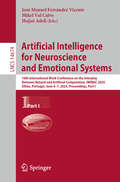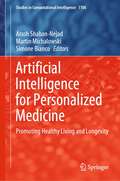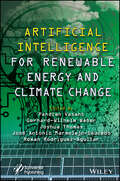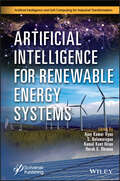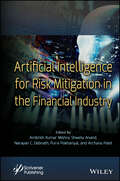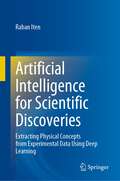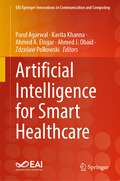- Table View
- List View
Artificial Intelligence for Neuroscience and Emotional Systems: 10th International Work-Conference on the Interplay Between Natural and Artificial Computation, IWINAC 2024, Olhâo, Portugal, June 4–7, 2024, Proceedings, Part I (Lecture Notes in Computer Science #14674)
by Hojjat Adeli José Manuel Ferrández Vicente Mikel Val CalvoThe two volume set LNCS 14674 and 14675 constitutes the proceedings of the 10th International Work-Conference on the Interplay Between Natural and Artificial Computation, IWINAC 2024, which took place in Olhâo, Portugal, during June 4–7, 2024. The 99 full papers presented in these proceedings were carefully reviewed and selected from 193 submissions. They were organized in topical sections as follows: Part I: Machine learning in neuroscience; artificial intelligence in neurophysiology; neuromotor and cognitive disorders; intelligent systems for assessment, treatment, and assistance in early stages of Alzheimer's disease and other dementias; socio-cognitive, affective and physiological computing; affective computing and context awareness in ambientintelliigence; learning tools to lecture; Part II: Machine learning in computer vision and robotics; bio-inspired computing approaches; social and civil engineering through human AI translations; smart renewable energies: advancing AI algorithms in the renewable energy industry; bioinspired applications.
Artificial Intelligence for Personalized Medicine: Promoting Healthy Living and Longevity (Studies in Computational Intelligence #1106)
by Arash Shaban-Nejad Martin Michalowski Simone BiancoThis book aims to highlight the latest achievements in the use of AI in personalized medicine and healthcare delivery. The edited book contains selected papers presented at the 2023 Health Intelligence workshop, co-located with the Thirty-Seven Association for the Advancement of Artificial Intelligence (AAAI) conference, and presents an overview of the issues, challenges, and potentials in the field, along with new research results. This book provides information for researchers, students, industry professionals, clinicians, and public health agencies interested in the applications of AI in medicine and public health.
Artificial Intelligence for Renewable Energy and Climate Change
by Pandian Vasant Gerhard Wilhelm Weber J. Joshua Thomas José Antonio Marmolejo-Saucedo Roman Rodriguez-AguilarARTIFICIAL INTELLIGENCE FOR RENEWABLE ENERGY AND CLIMATE CHANGE Written and edited by a global team of experts in the field, this groundbreaking new volume presents the concepts and fundamentals of using artificial intelligence in renewable energy and climate change, while also covering the practical applications that can be utilized across multiple disciplines and industries, for the engineer, the student, and other professionals and scientists. Renewable energy and climate change are two of the most important and difficult issues facing the world today. The state of the art in these areas is changing rapidly, with new techniques and theories coming online seemingly every day. It is important for scientists, engineers, and other professionals working in these areas to stay abreast of developments, advances, and practical applications, and this volume is an outstanding reference and tool for this purpose. The paradigm in renewable energy and climate change shifts constantly. In today’s international and competitive environment, lean and green practices are important determinants to increase performance. Corresponding production philosophies and techniques help companies diminish lead times and costs of manufacturing, improve delivery on time and quality, and at the same time become more ecological by reducing material use and waste, and by recycling and reusing. Those lean and green activities enhance productivity, lower carbon footprint and improve consumer satisfaction, which in reverse makes firms competitive and sustainable. This practical, new groundbreaking volume: Features coverage on a wide range of topics such as classical and nature-inspired optimization and optimal control, hybrid and stochastic systems Is ideally designed for engineers, scientists, industrialist, academicians, researchers, computer and information technologists, sustainable developers, managers, environmentalists, government leaders, research officers, policy makers, business leaders and students Is useful as a practical tool for practitioners in the fields of sustainable and renewable energy sustainability Includes wide coverage of how artificial intelligence can be used to impact the struggle against global warming and climate change
Artificial Intelligence for Renewable Energy and Climate Change
by Pandian Vasant Gerhard-Wilhelm Weber Joshua Thomas José Antonio Marmolejo-Saucedo Roman Rodriguez-AguilarARTIFICIAL INTELLIGENCE FOR RENEWABLE ENERGY AND CLIMATE CHANGE Written and edited by a global team of experts in the field, this groundbreaking new volume presents the concepts and fundamentals of using artificial intelligence in renewable energy and climate change, while also covering the practical applications that can be utilized across multiple disciplines and industries, for the engineer, the student, and other professionals and scientists. Renewable energy and climate change are two of the most important and difficult issues facing the world today. The state of the art in these areas is changing rapidly, with new techniques and theories coming online seemingly every day. It is important for scientists, engineers, and other professionals working in these areas to stay abreast of developments, advances, and practical applications, and this volume is an outstanding reference and tool for this purpose. The paradigm in renewable energy and climate change shifts constantly. In today’s international and competitive environment, lean and green practices are important determinants to increase performance. Corresponding production philosophies and techniques help companies diminish lead times and costs of manufacturing, improve delivery on time and quality, and at the same time become more ecological by reducing material use and waste, and by recycling and reusing. Those lean and green activities enhance productivity, lower carbon footprint and improve consumer satisfaction, which in reverse makes firms competitive and sustainable. This practical, new groundbreaking volume: Features coverage on a wide range of topics such as classical and nature-inspired optimization and optimal control, hybrid and stochastic systems Is ideally designed for engineers, scientists, industrialist, academicians, researchers, computer and information technologists, sustainable developers, managers, environmentalists, government leaders, research officers, policy makers, business leaders and students Is useful as a practical tool for practitioners in the fields of sustainable and renewable energy sustainability Includes wide coverage of how artificial intelligence can be used to impact the struggle against global warming and climate change
Artificial Intelligence for Renewable Energy Systems (Artificial Intelligence and Soft Computing for Industrial Transformation)
by Ajay Kumar Vyas S. Balamurugan Kamal Kant Hiran Harsh DhimanARTIFICIAL INTELLIGENCE FOR RENEWABLE ENERGY SYSTEMS Renewable energy systems, including solar, wind, biodiesel, hybrid energy, and other relevant types, have numerous advantages compared to their conventional counterparts. This book presents the application of machine learning and deep learning techniques for renewable energy system modeling, forecasting, and optimization for efficient system design. Due to the importance of renewable energy in today’s world, this book was designed to enhance the reader’s knowledge based on current developments in the field. For instance, the extraction and selection of machine learning algorithms for renewable energy systems, forecasting of wind and solar radiation are featured in the book. Also highlighted are intelligent data, renewable energy informatics systems based on supervisory control and data acquisition (SCADA); and intelligent condition monitoring of solar and wind energy systems. Moreover, an AI-based system for real-time decision-making for renewable energy systems is presented; and also demonstrated is the prediction of energy consumption in green buildings using machine learning. The chapter authors also provide both experimental and real datasets with great potential in the renewable energy sector, which apply machine learning (ML) and deep learning (DL) algorithms that will be helpful for economic and environmental forecasting of the renewable energy business. Audience The primary target audience includes research scholars, industry engineers, and graduate students working in renewable energy, electrical engineering, machine learning, information & communication technology.
Artificial Intelligence for Renewable Energy Systems (Artificial Intelligence and Soft Computing for Industrial Transformation)
by Ajay Kumar Vyas S. Balamurugan Kamal Kant Hiran Harsh S. DhimanARTIFICIAL INTELLIGENCE FOR RENEWABLE ENERGY SYSTEMS Renewable energy systems, including solar, wind, biodiesel, hybrid energy, and other relevant types, have numerous advantages compared to their conventional counterparts. This book presents the application of machine learning and deep learning techniques for renewable energy system modeling, forecasting, and optimization for efficient system design. Due to the importance of renewable energy in today’s world, this book was designed to enhance the reader’s knowledge based on current developments in the field. For instance, the extraction and selection of machine learning algorithms for renewable energy systems, forecasting of wind and solar radiation are featured in the book. Also highlighted are intelligent data, renewable energy informatics systems based on supervisory control and data acquisition (SCADA); and intelligent condition monitoring of solar and wind energy systems. Moreover, an AI-based system for real-time decision-making for renewable energy systems is presented; and also demonstrated is the prediction of energy consumption in green buildings using machine learning. The chapter authors also provide both experimental and real datasets with great potential in the renewable energy sector, which apply machine learning (ML) and deep learning (DL) algorithms that will be helpful for economic and environmental forecasting of the renewable energy business. Audience The primary target audience includes research scholars, industry engineers, and graduate students working in renewable energy, electrical engineering, machine learning, information & communication technology.
Artificial Intelligence for Risk Mitigation in the Financial Industry
by Narayan C. Debnath Archana Patel Purvi Pokhariyal Shweta Anand Ambrish Kumar MishraArtificial Intelligence for Risk Mitigation in the Financial Industry This book extensively explores the implementation of AI in the risk mitigation process and provides information for auditing, banking, and financial sectors on how to reduce risk and enhance effective reliability. The applications of the financial industry incorporate vast volumes of structured and unstructured data to gain insight into the financial and non-financial performance of companies. As a result of exponentially increasing data, auditors and management professionals need to enhance processing capabilities while maintaining the effectiveness and reliability of the risk mitigation process. The risk mitigation and audit procedures are processes involving the progression of activities to “transform inputs into output.” As AI systems continue to grow mainstream, it is difficult to imagine an aspect of risk mitigation in the financial industry that will not require AI-related assurance or AI-assisted advisory services. AI can be used as a strong tool in many ways, like the prevention of fraud, money laundering, and cybercrime, detection of risks and probability of NPAs at early stages, sound lending, etc. Audience This is an introductory book that provides insights into the advantages of risk mitigation by the adoption of AI in the financial industry. The subject is not only restricted to individuals like researchers, auditors, and management professionals, but also includes decision-making authorities like the government. This book is a valuable guide to the utilization of AI for risk mitigation and will serve as an important standalone reference for years to come.
Artificial Intelligence for Risk Mitigation in the Financial Industry
by Ambrish Kumar Mishra Shweta Anand Narayan C. Debnath Archana PatelArtificial Intelligence for Risk Mitigation in the Financial Industry This book extensively explores the implementation of AI in the risk mitigation process and provides information for auditing, banking, and financial sectors on how to reduce risk and enhance effective reliability. The applications of the financial industry incorporate vast volumes of structured and unstructured data to gain insight into the financial and non-financial performance of companies. As a result of exponentially increasing data, auditors and management professionals need to enhance processing capabilities while maintaining the effectiveness and reliability of the risk mitigation process. The risk mitigation and audit procedures are processes involving the progression of activities to “transform inputs into output.” As AI systems continue to grow mainstream, it is difficult to imagine an aspect of risk mitigation in the financial industry that will not require AI-related assurance or AI-assisted advisory services. AI can be used as a strong tool in many ways, like the prevention of fraud, money laundering, and cybercrime, detection of risks and probability of NPAs at early stages, sound lending, etc. Audience This is an introductory book that provides insights into the advantages of risk mitigation by the adoption of AI in the financial industry. The subject is not only restricted to individuals like researchers, auditors, and management professionals, but also includes decision-making authorities like the government. This book is a valuable guide to the utilization of AI for risk mitigation and will serve as an important standalone reference for years to come.
Artificial Intelligence for Robotics: Build intelligent robots that perform human tasks using AI techniques
by Francis X. GoversBring a new degree of interconnectivity to your world by building your own intelligent robots Key Features Leverage fundamentals of AI and robotics Work through use cases to implement various machine learning algorithms Explore Natural Language Processing (NLP) concepts for efficient decision making in robots Book Description Artificial Intelligence for Robotics starts with an introduction to Robot Operating Systems (ROS), Python, robotic fundamentals, and the software and tools that are required to start out with robotics. You will learn robotics concepts that will be useful for making decisions, along with basic navigation skills. As you make your way through the chapters, you will learn about object recognition and genetic algorithms, which will teach your robot to identify and pick up an irregular object. With plenty of use cases throughout, you will explore natural language processing (NLP) and machine learning techniques to further enhance your robot. In the concluding chapters, you will learn about path planning and goal-oriented programming, which will help your robot prioritize tasks. By the end of this book, you will have learned to give your robot an artificial personality using simulated intelligence. What you will learn Get started with robotics and artificial intelligence Apply simulation techniques to give your robot an artificial personality Understand object recognition using neural networks and supervised learning techniques Pick up objects using genetic algorithms for manipulation Teach your robot to listen using NLP via an expert system Use machine learning and computer vision to teach your robot how to avoid obstacles Understand path planning, decision trees, and search algorithms in order to enhance your robot Who this book is for If you have basic knowledge about robotics and want to build or enhance your existing robot's intelligence, then Artificial Intelligence for Robotics is for you. This book is also for enthusiasts who want to gain knowledge of AI and robotics.
Artificial Intelligence for Robotics: Build intelligent robots that perform human tasks using AI techniques
by Francis X. GoversBring a new degree of interconnectivity to your world by building your own intelligent robots Key Features Leverage fundamentals of AI and robotics Work through use cases to implement various machine learning algorithms Explore Natural Language Processing (NLP) concepts for efficient decision making in robots Book Description Artificial Intelligence for Robotics starts with an introduction to Robot Operating Systems (ROS), Python, robotic fundamentals, and the software and tools that are required to start out with robotics. You will learn robotics concepts that will be useful for making decisions, along with basic navigation skills. As you make your way through the chapters, you will learn about object recognition and genetic algorithms, which will teach your robot to identify and pick up an irregular object. With plenty of use cases throughout, you will explore natural language processing (NLP) and machine learning techniques to further enhance your robot. In the concluding chapters, you will learn about path planning and goal-oriented programming, which will help your robot prioritize tasks. By the end of this book, you will have learned to give your robot an artificial personality using simulated intelligence. What you will learn Get started with robotics and artificial intelligence Apply simulation techniques to give your robot an artificial personality Understand object recognition using neural networks and supervised learning techniques Pick up objects using genetic algorithms for manipulation Teach your robot to listen using NLP via an expert system Use machine learning and computer vision to teach your robot how to avoid obstacles Understand path planning, decision trees, and search algorithms in order to enhance your robot Who this book is for If you have basic knowledge about robotics and want to build or enhance your existing robot's intelligence, then Artificial Intelligence for Robotics is for you. This book is also for enthusiasts who want to gain knowledge of AI and robotics.
Artificial Intelligence for Robotics: Build Intelligent Robots That Perform Human Tasks Using Ai Techniques
by Francis X. GoversArtificial Intelligence is arguably the most exciting and disruptive field of robotics which makes a man-made machine intelligent. This book will fulfill this vision by introducing various machine learning concepts to make your robot efficient. It will also equip your robot to make decisions, learn, and adapt based on its environment.
Artificial Intelligence for Robotics: Build intelligent robots using ROS 2, Python, OpenCV, and AI/ML techniques for real-world tasks
by Francis X. Govers IIILearn how to apply artificial intelligence, engineering, and machine learning to create smart robots capable of interacting with their environment, engaging with users, making decisions, and navigating autonomouslyKey FeaturesGain a holistic understanding of robot design, systems engineering, and task analysisImplement AI/ML techniques to detect and manipulate objects and navigate robots using landmarksIntegrate voice and natural language interactions to create a digital assistant and artificial personality for your robotPurchase of the print or Kindle book includes a free PDF eBookBook DescriptionUnlock the potential of your robots by enhancing their perception with cutting-edge artificial intelligence and machine learning techniques. From neural networks to computer vision, this book equips you with the tools and practical use cases to create truly smart robots. Starting with robotics basics, robot architecture, control systems, and decision-making theory, this book presents systems-engineering methods to design problem-solving robots with single-board computers. You’ll explore object recognition and genetic algorithms to teach your robot to identify and pick up objects, and you'll also harness the power of natural language processing to give your robot a voice. To enhance your robot further, you’ll master neural networks to classify and separate objects and navigate autonomously, before advancing to guiding your robot arms using reinforcement learning and genetic algorithms. The book also covers path planning and goal-oriented programming to prioritize your robot's tasks, showing you how to connect all software using Python and ROS 2 for a seamless experience. By the end of this book, you’ll have learned how to transform your robot into a helpful assistant with NLP and give it an artificial personality, ready to tackle real-world tasks and even crack jokes.What you will learnGet started with robotics and AI essentialsUnderstand path planning, decision trees, and search algorithms to enhance your robotExplore object recognition using neural networks and supervised learning techniquesEmploy genetic algorithms to enable your robot arm to manipulate objectsTeach your robot to listen using Natural Language Processing through an expert systemProgram your robot in how to avoid obstacles and retrieve objects with machine learning and computer visionApply simulation techniques to give your robot an artificial personalityWho this book is forThis book is for practicing robotics engineers and enthusiasts aiming to advance their skills by applying AI and ML techniques. Students and researchers looking for practical guidance for solving specific problems or approaching a difficult robot design will find this book insightful. Proficiency in Python programming, familiarity with electronics and wiring, single board computers, Linux-based command-line interface (CLI), and knowledge of AI/ML concepts are required to get started with this book.
Artificial Intelligence for Robotics and Autonomous Systems Applications (Studies in Computational Intelligence #1093)
by Ahmad Taher Azar Anis KoubaaThis book addresses many applications of artificial intelligence in robotics, namely AI using visual and motional input. Robotic technology has made significant contributions to daily living, industrial uses, and medicinal applications. Machine learning, in particular, is critical for intelligent robots or unmanned/autonomous systems such as UAVs, UGVs, UUVs, cooperative robots, and so on. Humans are distinguished from animals by capacities such as receiving visual information, adjusting to uncertain circumstances, and making decisions to take action in a complex system. Significant progress has been made in robotics toward human-like intelligence; yet, there are still numerous unresolved issues. Deep learning, reinforcement learning, real-time learning, swarm intelligence, and other developing approaches such as tiny-ML have been developed in recent decades and used in robotics.Artificial intelligence is being integrated into robots in order to develop advanced robotics capable of performing multiple tasks and learning new things with a better perception of the environment, allowing robots to perform critical tasks with human-like vision to detect or recognize various objects. Intelligent robots have been successfully constructed using machine learning and deep learning AI technology. Robotics performance is improving as higher quality, and more precise machine learning processes are used to train computer vision models to recognize different things and carry out operations correctly with the desired outcome.We believe that the increasing demands and challenges offered by real-world robotic applications encourage academic research in both artificial intelligence and robotics. The goal of this book is to bring together scientists, specialists, and engineers from around the world to present and share their most recent research findings and new ideas on artificial intelligence in robotics.
Artificial Intelligence for Safety and Reliability Engineering: Methods, Applications, and Challenges (Springer Series in Reliability Engineering)
by Kim Phuc TranThis book is a comprehensive exploration of the latest theoretical research, technological advancements, and real-world applications of artificial intelligence (AI) for safety and reliability engineering. Smart manufacturing relies on predictive maintenance (PdM) to ensure sustainable production systems, and the integration of AI has become increasingly prevalent in this field. This book serves as a valuable resource for researchers, practitioners, and decision-makers in manufacturing. By combining theoretical research, practical applications, and case studies, it equips readers with the necessary knowledge and tools to implement AI for safety and reliability engineering effectively in smart manufacturing contexts.
Artificial Intelligence for Science and Engineering Applications
by Shahab D. MohagheghArtificial Intelligence (AI) is defined as the simulation of human intelligence through the mimicking of the human brain for analysis, modeling, and decision‑making. Science and engineering problem solving requires modeling of physical phenomena, and humans approach the solution of scientific and engineering problems differently from other problems. Artificial Intelligence for Science and Engineering Applications addresses the unique differences in how AI should be developed and used in science and engineering. Through the inclusion of definitions and detailed examples, this book describes the actual and realistic requirements as well as what characteristics must be avoided for correct and successful science and engineering applications of AI.This book:• Offers a brief history of AI and covers science and engineering applications• Explores the modeling of physical phenomena using AI• Discusses explainable AI (XAI) applications• Covers the ethics of AI in science and engineering• Features real‑world case studiesOffering a probing view into the unique nature of scientific and engineering exploration, this book will be of interest to generalists and experts looking to expand their understanding of how AI can better tackle and advance technology and developments in scientific and engineering disciplines.
Artificial Intelligence for Science and Engineering Applications
by Shahab D. MohagheghArtificial Intelligence (AI) is defined as the simulation of human intelligence through the mimicking of the human brain for analysis, modeling, and decision‑making. Science and engineering problem solving requires modeling of physical phenomena, and humans approach the solution of scientific and engineering problems differently from other problems. Artificial Intelligence for Science and Engineering Applications addresses the unique differences in how AI should be developed and used in science and engineering. Through the inclusion of definitions and detailed examples, this book describes the actual and realistic requirements as well as what characteristics must be avoided for correct and successful science and engineering applications of AI.This book:• Offers a brief history of AI and covers science and engineering applications• Explores the modeling of physical phenomena using AI• Discusses explainable AI (XAI) applications• Covers the ethics of AI in science and engineering• Features real‑world case studiesOffering a probing view into the unique nature of scientific and engineering exploration, this book will be of interest to generalists and experts looking to expand their understanding of how AI can better tackle and advance technology and developments in scientific and engineering disciplines.
Artificial Intelligence for Scientific Discoveries: Extracting Physical Concepts from Experimental Data Using Deep Learning
by Raban ItenWill research soon be done by artificial intelligence, thereby making human researchers superfluous? This book explains modern approaches to discovering physical concepts with machine learning and elucidates their strengths and limitations. The automation of the creation of experimental setups and physical models, as well as model testing are discussed. The focus of the book is the automation of an important step of the model creation, namely finding a minimal number of natural parameters that contain sufficient information to make predictions about the considered system. The basic idea of this approach is to employ a deep learning architecture, SciNet, to model a simplified version of a physicist's reasoning process. SciNet finds the relevant physical parameters, like the mass of a particle, from experimental data and makes predictions based on the parameters found. The author demonstrates how to extract conceptual information from such parameters, e.g., Copernicus' conclusion that the solar system is heliocentric.
Artificial Intelligence for Security: Enhancing Protection in a Changing World
by Tuomo Sipola Tero Kokkonen Janne Alatalo Monika WolfmayrThis book discusses the use of artificial intelligence (AI) for security purposes. It is divided into three parts: methodological fundamentals of AI, use of AI for critical infrastructure protection and anomaly detection. The first section describes the latest knowledge for creating safe AIs and using them to enhance protection. This book also presents various domains and examples of AI-driven security. The chapters describe potential methods, demonstrate use cases and discuss the challenges of the evolving field. This includes topics such as defensive use of AI to detect threats. It discusses the offensive use of AI to better understand the future threat landscape, the use of AI for automation in critical infrastructure and overall challenges of AI usage for critical tasks. As new threats emerge, the use of AI technologies to protect the world one lives in is topical. New technologies in this space have advanced rapidly, and subsequently, their use in enhancing protection is an evident development. To this effect, this book brings together a group of international researchers and professionals who present their views on how to create security through AI. This book targets postgraduate students, researchers and professionals who want to understand the use of AI for security. Understanding latest advancements in this field will also be useful to those who want to comprehend modern cybersecurity in detail and who want to follow research and latest trends.
Artificial Intelligence for Smart Healthcare (EAI/Springer Innovations in Communication and Computing)
by Parul Agarwal Kavita Khanna Ahmed A. Elngar Ahmed J. Obaid Zdzislaw PolkowskiThis book provides information on interdependencies of medicine and telecommunications engineering and how the two must rely on each other to effectively function in this era. The book discusses new techniques for medical service improvisation such as clear-cut views on medical technologies. The authors provide chapters on communication essentiality in healthcare, processing of medical amenities using medical images, the importance of data and information technology in medicine, and machine learning and artificial intelligence in healthcare. Authors include researchers, academics, and professionals in the field.
Artificial Intelligence for Smart Manufacturing: Methods, Applications, and Challenges (Springer Series in Reliability Engineering)
by Kim Phuc TranThis book provides readers with a comprehensive overview of the latest developments in the field of smart manufacturing, exploring theoretical research, technological advancements, and practical applications of AI approaches. With Industry 4.0 paving the way for intelligent systems and innovative technologies to enhance productivity and quality, the transition to Industry 5.0 has introduced a new concept known as augmented intelligence (AuI), combining artificial intelligence (AI) with human intelligence (HI).As the demand for smart manufacturing continues to grow, this book serves as a valuable resource for professionals and practitioners looking to stay up-to-date with the latest advancements in Industry 5.0. Covering a range of important topics such as product design, predictive maintenance, quality control, digital twin, wearable technology, quantum, and machine learning, the book also features insightful case studies that demonstrate the practical application of these tools in real-world scenarios.Overall, this book provides a comprehensive and up-to-date account of the latest advancements in smart manufacturing, offering readers a valuable resource for navigating the challenges and opportunities presented by Industry 5.0.
Artificial Intelligence for Smart Technology in the Hospitality and Tourism Industry
by Amit Verma Vinod Kumar Shukla Jean Paolo G. LacapThis informative volume on the shifting requirements of the hospitality service industry aims to incorporate smart information technology into tourism services. A resource written specifically for tourism service industry professionals, it provides a focused approach to introducing Industry 4.0-related technologies. It explains how artificial intelligence can support a company’s strategy to revolutionize the business by using smart technology most effectively. The chapters explore artificial intelligence, Internet of Things, big data, blockchain, and automation and robotics in the hospitality industry.
Artificial Intelligence for Smart Technology in the Hospitality and Tourism Industry
This informative volume on the shifting requirements of the hospitality service industry aims to incorporate smart information technology into tourism services. A resource written specifically for tourism service industry professionals, it provides a focused approach to introducing Industry 4.0-related technologies. It explains how artificial intelligence can support a company’s strategy to revolutionize the business by using smart technology most effectively. The chapters explore artificial intelligence, Internet of Things, big data, blockchain, and automation and robotics in the hospitality industry.
Artificial Intelligence for Societal Issues (Intelligent Systems Reference Library #231)
by Anupam Biswas Vijay Bhaskar Semwal Durgesh SinghArtificial intelligence (AI) has the potential to provide innovative solutions to various societal issues and real-world social challenges. AI is useful in combating some of the seemingly unsolvable social crises facing the world today. Be it disaster awareness and management or demand forecasting, or healthcare informatics or disease outbreaks like COVID-19, the AI plays a pivotal role everywhere. AI has the potential to address some of the societal issues that indirectly pose challenges like cybercrime, agriculture, education, economy, and health. The book covers several applications of AI as solutions to different societal issues, which include economic empowerment, smart education system, COVID-19 detection & management, emotion detection, fraudulent transactions, applications in agriculture and health informatics, etc. The book will be helpful for the academicians and researchers working with various areas of societal issues, data science, artificial intelligence, and machine learning.
Artificial Intelligence for Space: Trends, Applications, and Perspectives
by Matteo Madi Olga SokolovaThe new age space value chain is a complex interconnected system with diverse actors, which involves cross-sector and cross-border collaborations. This book helps to enrich the knowledge of Artificial Intelligence (AI) across the value chain in the space-related domains. Advancements of AI and Machine Learning have impactfully supported the space sector transformation as it is shown in the book. "This book embarks on a journey through the fascinating realm of AI in space, exploring its profound implications, emerging trends, and transformative potential." Prof. mult. Dr.med. Dr.rer.nat. Oliver UllrichDirector Innovation Cluster Space and Aviaton (UZH Space Hub), University of Zurich, Switzerland Aimed at space engineers, risk analysts, policy makers, technical experts and non-specialists, this book demonstrates insights into the implementation of AI in the space sector, alongside its limitations and use-case examples. It covers diverse AI-related topics applicable to space technologies or space big data such as AI-based technologies for improving Earth Observation big data, AI for space robotics exploration, AI for astrophysics, AI for emerging in-orbit servicing market, and AI for space tourism safety improvement. Key Features: Provides an interdisciplinary approach, with chapter contributions from expert teams working in the governmental or private space sectors, with valuable contributions from computer scientists and legal experts; Presents insights into AI implementation and how to unlock AI technologies in the field; Up to date with the latest developments and cutting-edge applications Matteo Madi, Ph.D., is an entrepreneur, innovator, business developer and space-tech specialist with many years of experiences in the Swiss and International public and private sectors. He is the founder of Sirin Orbital Systems AG, a Swiss innovative company based in Zurich, focused on the development and commercialization of advanced enabling technologies for the needs of emerging space market and future sustainable space exploration. It also creates innovative solutions for the use of space technologies and satellite-based services for terrestrial applications. Olga Sokolova, Ph.D., is a risk analyst proficient in critical infrastructure risk assessment to natural and technical hazards. She has been engaged in development and analysis of structural risk-management tools towards sustainable future and has a record in raising social awareness of spaceborne risks and opportunities brought to the society by the "New Space" industry developments. Along with Dr. M. Madi, Dr. O. Sokolova is the Co-Editor of the book entitled, "Space Debris Peril: Pathways to Opportunities", published by CRC Press: Taylor and Francis in November 2020 (ISBN 9780367469450).
Artificial Intelligence for Space: Trends, Applications, and Perspectives
by Matteo Madi Olga SokolovaThe new age space value chain is a complex interconnected system with diverse actors, which involves cross-sector and cross-border collaborations. This book helps to enrich the knowledge of Artificial Intelligence (AI) across the value chain in the space-related domains. Advancements of AI and Machine Learning have impactfully supported the space sector transformation as it is shown in the book. "This book embarks on a journey through the fascinating realm of AI in space, exploring its profound implications, emerging trends, and transformative potential." Prof. mult. Dr.med. Dr.rer.nat. Oliver UllrichDirector Innovation Cluster Space and Aviaton (UZH Space Hub), University of Zurich, Switzerland Aimed at space engineers, risk analysts, policy makers, technical experts and non-specialists, this book demonstrates insights into the implementation of AI in the space sector, alongside its limitations and use-case examples. It covers diverse AI-related topics applicable to space technologies or space big data such as AI-based technologies for improving Earth Observation big data, AI for space robotics exploration, AI for astrophysics, AI for emerging in-orbit servicing market, and AI for space tourism safety improvement. Key Features: Provides an interdisciplinary approach, with chapter contributions from expert teams working in the governmental or private space sectors, with valuable contributions from computer scientists and legal experts; Presents insights into AI implementation and how to unlock AI technologies in the field; Up to date with the latest developments and cutting-edge applications Matteo Madi, Ph.D., is an entrepreneur, innovator, business developer and space-tech specialist with many years of experiences in the Swiss and International public and private sectors. He is the founder of Sirin Orbital Systems AG, a Swiss innovative company based in Zurich, focused on the development and commercialization of advanced enabling technologies for the needs of emerging space market and future sustainable space exploration. It also creates innovative solutions for the use of space technologies and satellite-based services for terrestrial applications. Olga Sokolova, Ph.D., is a risk analyst proficient in critical infrastructure risk assessment to natural and technical hazards. She has been engaged in development and analysis of structural risk-management tools towards sustainable future and has a record in raising social awareness of spaceborne risks and opportunities brought to the society by the "New Space" industry developments. Along with Dr. M. Madi, Dr. O. Sokolova is the Co-Editor of the book entitled, "Space Debris Peril: Pathways to Opportunities", published by CRC Press: Taylor and Francis in November 2020 (ISBN 9780367469450).
